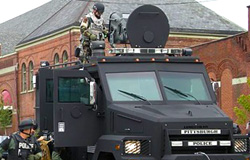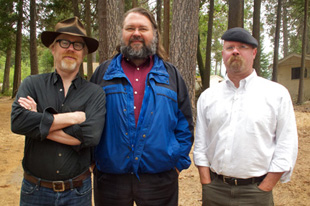![]() There’s a big problem with the Big Bang. A Big Audio Problem.
There’s a big problem with the Big Bang. A Big Audio Problem.
The background noise thrown up by the current rush of theories – p-branes, inflation, a bubble universe, multiple Big Bangs and their like – has drowned out the impossibility of a bang of any kind occurring where no gasses or fluids yet exist.
But then, you can’t believe everything you hear about sound…
My earliest recollection of sound’s ‘alternative’ applications came from a children’s science book. A story called ‘Deadly Frequency 7’ described the destructive power of very low frequencies (infrasound). It talked about office absenteeism being attributed to air conditioning system resonance, Vladimir Gavronsky’s infrasonic whistle of the 1960s and of experimental sonic weaponry. I was fascinated. The story probably played an important part in my subsequent involvement in sound and music.
Writing this, I wondered if the same story might have played a part in inspiring Kate Bush to write ‘Experiment IV’ – a song about a military experiment in sound to create ‘a sound that can kill someone from a distance’. It seemed entirely possible (we’re very nearly the same age). I checked her own notes that accompanied the song’s press promo but they confined themselves to songwriting and drummers.
Certainly, sound can be used to change the way that people feel and the way that they behave. Putting aside the benevolence of music therapy, the Nazis used music to exert psychological stress (distinct from physical effects) on torture victims during WWII, and the US Army used it to inspire its troops and disorientate its foes in Iraq. A little reminiscent of the Classic Ipcress File brainwashing scenes, meanwhile, the first series of Homeland shows grindcore band Gridlink used in a ruthless interrogation sequence. The common theme here is not to cause the kind of damage inflicted by conventional weapons, but the application of sound in support of other weapons and wartime practices. But that’s not to say that it can’t be done.
S ound cannons have been used by police to disperse protesters (during the G20 summit in Pittsburgh, for example), and I can confirm the effectiveness of white noise played through the PA system as a means of emptying a nightclub in the early hours. High-pitched ‘mosquito’ devices are currently used to discourage teenagers from loitering around railway stations and shop fronts. Cleverly, this exploits the better sensitivity of young ears to high frequencies to target its audience.
ound cannons have been used by police to disperse protesters (during the G20 summit in Pittsburgh, for example), and I can confirm the effectiveness of white noise played through the PA system as a means of emptying a nightclub in the early hours. High-pitched ‘mosquito’ devices are currently used to discourage teenagers from loitering around railway stations and shop fronts. Cleverly, this exploits the better sensitivity of young ears to high frequencies to target its audience.
There are actual electronic mosquito repellents (EMRs) that use ultrasound. These are based on producing the sound of territorial males but miss the point that real mosquito communication takes place with the range of human hearing. Basically, they are useless. Pretty basic error here...
Moving down the pitch scale to below the limits of human hearing, we enter the world of infrasound. In the hands of renowned recording studio designer Tom Hidley, a loudspeaker monitor system capable of reaching around 9Hz is a valid recording tool and he designed South Africa’s BOP Studios with this in mind.
Other perceived uses of infrasound return us to ‘Deadly Frequency 7’.
The US Department of Defense has experimented with phased arrays of infrasonic emitters operating at around 7Hz, to which armour and building provide little or no protection. According to Global Security.org, this ‘high-intensity, low-frequency sound may cause [human] organs to resonate, causing a number of physiological results’.
Take note…
Among sound’s urban myths are the ‘brown note’ (a frequency causing involuntary evacuation of the bowels) and ‘fear frequencies’. At around 19Hz, these are said to ‘cause feelings of discomfort and even outright terror’. This is great coffee table science and has inevitably invited scrutiny outside military circles. In television documentaries, for example…
 In the UK, a series called Brainiac: Science Abuse experimented with 22.275Hz, including a facile attempt to test it on a television audience. Rather than uncovering any truth to the myth, this simply added to it. No reference to the show’s loudspeaker system was made, but it was clearly an Akai S950 (12-bit) sampler at the head of the chain – not a good choice.
In the UK, a series called Brainiac: Science Abuse experimented with 22.275Hz, including a facile attempt to test it on a television audience. Rather than uncovering any truth to the myth, this simply added to it. No reference to the show’s loudspeaker system was made, but it was clearly an Akai S950 (12-bit) sampler at the head of the chain – not a good choice.
Rather better efforts have been made by the Discovery Channel’s MythBusters, which investigated the ‘brown note’ in 2005 and recently turned its attention to ‘fear frequencies’. Both experiments saw the programme’s presenters, Adam Savage and Jamie Hyneman, call on Meyer Sound for some serious speaker action.
The ‘brown note’ experiment used 12 modified Meyer Sound 700-HP subwoofers to put out 5Hz (108dB), 7Hz (114dB) and 9Hz (120dB) tones, as well as a sweep of 20Hz-100Hz at 154dB without any material results beyond blurred vision and modulated speech). The audio signals came from a Meyer Sound SIM 3 with software modified to produce infrasonic tones. A B&K sound analyser, fed with an attenuated signal from a B&K 4189 mic, monitored the sound pressure levels. Take note Brainiac…
Having failed to find any substance in the ‘brown note’, Mythbusters returned to sound experimentation recently to investigate ‘fear frequencies’. Recruiting ten volunteers, they decamped to four abandoned cabins at a remote forest resort in Northern California. ‘One cabin was subjected to infrasonic sound while the other control cabins had no sound,’ says Dr Roger Schwenke, Meyer Sound staff scientist and ‘honorary’ MythBuster, who was involved in both programmes.
‘Although the cabins were essentially identical, the idea was to ask the participants if one cabin seemed more eerie or frightening than the others. We used U-shaped array to get nine modified Meyer Sound 1100-LFC elements as close together as possible, and to direct any higher overtones away from the cabin so we could get the infrasonic level as high as possible without anything being audible.
‘We had to be careful with the level because, at around 95dB, we started rattling the cabin walls,’ he says. ‘That would have been a dead giveaway. But I did feel a sense of unease. You could tell when it was on even though you couldn’t hear anything. It was more of a whole-body, change-in-the-air sensation, an undefined ominous feeling.’ The Mythbusters verdict was ‘myth busted’, however, as no consistent evidence was collected. Again.
See, hear
 One opportunity that seems to have been overlooked by both mythmakers and mythbusters is synaesthesia – specifically chromaesthesia. A neurological condition, this causes sensory crosstalk that allows synesthetes to ‘see’ the sounds that they hear. It is well documented among musicians including Duke Ellington, Itzhak Perlman and the Aphex Twin, and artists Wassily Kandinsky and David Hockney. What’s missing here is not a study of the condition itself, but establishing its technical spec.
One opportunity that seems to have been overlooked by both mythmakers and mythbusters is synaesthesia – specifically chromaesthesia. A neurological condition, this causes sensory crosstalk that allows synesthetes to ‘see’ the sounds that they hear. It is well documented among musicians including Duke Ellington, Itzhak Perlman and the Aphex Twin, and artists Wassily Kandinsky and David Hockney. What’s missing here is not a study of the condition itself, but establishing its technical spec.
Does synaesthesia map hearing faithfully? If not, where does it kick in and out? Is it level dependent? Does it reflect the Fletcher-Munson equal loudness contour in any way?
What about it – bandwidth, dynamic range, sensitivity, intermod distortion, gain ranging... Am I the only one who has considered this? (Or is someone lining it up for their dissertation?)
While we have Mythbusters and Meyer Sound to thank for helping debunk the ‘brown note’ and ‘fear frequency’ stories, I think I’m going to call on my local Buddhist Centre for help with the Big Bang… would it make a sound if there were nobody there to hear it?
If it did, was it a bang?






